Political Map of Scotland Redrawn
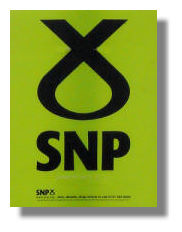 When the voting system for the devolved Scottish Parliament was drawn up, it was essential to introduce an element of proportional representation. Otherwise, a "first past the post" system would have produced a perpetual Labour government. In the first two elections, the majority Labour party needed the support of the Liberal Democrats to create a coalition government. This week, the Scottish National Party (SNP) became the largest single party - but by the slenderest margin of one seat. Now, neither the SNP or Labour have enough seats to form a majority coalition with the Liberal Democrats - even if the LibDems wanted to join such an alliance. The full results of Thursday's election were:
When the voting system for the devolved Scottish Parliament was drawn up, it was essential to introduce an element of proportional representation. Otherwise, a "first past the post" system would have produced a perpetual Labour government. In the first two elections, the majority Labour party needed the support of the Liberal Democrats to create a coalition government. This week, the Scottish National Party (SNP) became the largest single party - but by the slenderest margin of one seat. Now, neither the SNP or Labour have enough seats to form a majority coalition with the Liberal Democrats - even if the LibDems wanted to join such an alliance. The full results of Thursday's election were:
| | Constituency
Seats | Regional
Seats | Total | Gain/Loss
On 2003 |
| SNP | 21 | 26 | 47 | +20 |
| Labour | 37 | 9 | 46 | -4 |
| Conservative | 4 | 13 | 17 | -1 |
| Lib/Dem | 11 | 5 | 16 | -1 |
| Green | 0 | 2 | 2 | -5 |
| Independent | 0 | 1 | 1 | -5 |
| SSP | 0 | 0 | 0 | -6 |
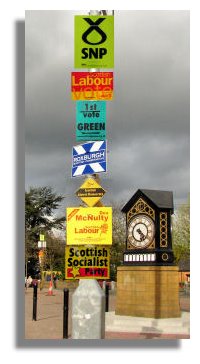 While the SNP made major gains, the Labour Party did not lose as many seats as had been predicted - it had been thought that, even though this was a Scottish election, many voters wanted to "give Tony Blair a kicking". It was the smaller parties - Green Party, Scottish Socialists and Independents who were squeezed out. Even the Conservatives and Liberal Democrats lost ground.
While the SNP made major gains, the Labour Party did not lose as many seats as had been predicted - it had been thought that, even though this was a Scottish election, many voters wanted to "give Tony Blair a kicking". It was the smaller parties - Green Party, Scottish Socialists and Independents who were squeezed out. Even the Conservatives and Liberal Democrats lost ground.
Before the election, the Liberal Democrats had suggested that if the SNP became the largest party, they might join a coalition with them - but only if the SNP abandoned their pledge to hold a referendum on Scotland leaving the United Kingdom. Now that the Scottish electorate has voted, all the parties are now having to consider their next move. The SNP leader, Alex Salmond, is convinced that he has the moral authority to become the First Minister. The elected representatives have to vote on that within 28 days of the election. The finely balanced result created by the Scottish electorate may mean that the future government of Scotland will require the sort of consensus politics that we were originally promised, back in the run-up to the devolved parliament in the 1990s. Watch this space!
Electoral Shambles
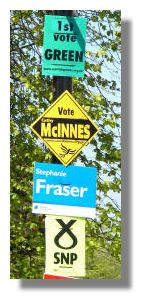 No, the result was not a shambles. But due to a combination of factors, the election process itself became almost farcical, detracting attention from the results themselves. It meant that over 100,000 ballot papers were rejected due to being incorrectly completed - that's about 5% of all the votes and more than enough to have made a big difference in the outcome. First of all, a huge increase in the number of applications for a postal vote, resulted in many postal ballot papers not arriving before polling day. Then the ballot papers for the constituency vote and the regional list were combined onto one ballot paper. Confronted with a long list of candidates and a statement at the top that "You have two votes" induced some voters to put two crosses in one column, instead of one in each. Having "Alex Salmond for First Minister" at the top of the regional list also threw some people. It was a smart and legal move to head the alphabetical list, but he wasn't standing as a regional candidate in most regions. Then, to confuse us further, the election for local government candidates was held on the same day. Due to the "single transferable vote" system, voters here had to record their preferences in numerical order - 1,2,3 etc. After decades of putting a cross on the ballot paper, that proved confusing for some. Then the ballot papers had to be put in the boxes unfolded for the sake of the electronic readers. The electronic equipment reading all the ballot papers, faced with a large number of rejections, struggled to cope and delayed the production of the results. The Electoral Commission is to undertake a full enquiry into what went wrong and there are calls for a full, independent investigation.
No, the result was not a shambles. But due to a combination of factors, the election process itself became almost farcical, detracting attention from the results themselves. It meant that over 100,000 ballot papers were rejected due to being incorrectly completed - that's about 5% of all the votes and more than enough to have made a big difference in the outcome. First of all, a huge increase in the number of applications for a postal vote, resulted in many postal ballot papers not arriving before polling day. Then the ballot papers for the constituency vote and the regional list were combined onto one ballot paper. Confronted with a long list of candidates and a statement at the top that "You have two votes" induced some voters to put two crosses in one column, instead of one in each. Having "Alex Salmond for First Minister" at the top of the regional list also threw some people. It was a smart and legal move to head the alphabetical list, but he wasn't standing as a regional candidate in most regions. Then, to confuse us further, the election for local government candidates was held on the same day. Due to the "single transferable vote" system, voters here had to record their preferences in numerical order - 1,2,3 etc. After decades of putting a cross on the ballot paper, that proved confusing for some. Then the ballot papers had to be put in the boxes unfolded for the sake of the electronic readers. The electronic equipment reading all the ballot papers, faced with a large number of rejections, struggled to cope and delayed the production of the results. The Electoral Commission is to undertake a full enquiry into what went wrong and there are calls for a full, independent investigation.
Exam Time for 160,000 Scots Pupils
The Standard Grade and Higher examinations, which pupils take in their final years at secondary school, began this week. Between now and 8 June, 160,000 pupils, aged 16-18, will sit 2.3 million exam papers. Then an army of nearly 10,000 markers will assess their efforts, so that the results can be made available in August. Following a successful experiment last year, students will be able to sign up to go online to check their results once they are ready to be published. That will be just as nerve-wracking as waiting for the postman to drop the envelope through the letter-box, however.
Scotland's Busiest Tourist Attractions
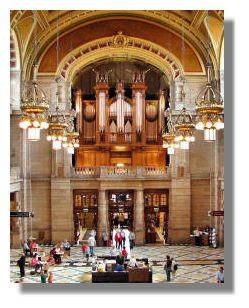 This week, the tourism agency VisitScotland published the figures on the number of visitors to Scotland's top tourist attractions last year. Nobody was surprised that the newly refurbished Kelvingrove Art Gallery and Museum (pictured here) had overtaken Edinburgh Castle for the top spot. Despite only being open for less than six months in 2006, Kelvingrove welcomed 1.9 visitors. Edinburgh Castle, with 1.2 million people through its gates, was the second busiest location - and the top location with an entrance fee. Edinburgh Zoo and Edinburgh Bus Tours followed the castle as Scotland's top paid-for attractions. Glasgow Science Centre and Blair Drummond Safari Park were 4th and 5th respectively. Of the free attractions, the National Gallery of Scotland and the National Museum of Scotland (both in Edinburgh) were high on the list, followed by the Old Blacksmith's Shop Centre in Gretna Green and Edinburgh's Royal Botanic Garden. Rosslyn Chapel in Midlothian, made famous by Dan Brown's best-selling novel, The Da Vinci code, saw numbers almost double between 2005 and 2006.
This week, the tourism agency VisitScotland published the figures on the number of visitors to Scotland's top tourist attractions last year. Nobody was surprised that the newly refurbished Kelvingrove Art Gallery and Museum (pictured here) had overtaken Edinburgh Castle for the top spot. Despite only being open for less than six months in 2006, Kelvingrove welcomed 1.9 visitors. Edinburgh Castle, with 1.2 million people through its gates, was the second busiest location - and the top location with an entrance fee. Edinburgh Zoo and Edinburgh Bus Tours followed the castle as Scotland's top paid-for attractions. Glasgow Science Centre and Blair Drummond Safari Park were 4th and 5th respectively. Of the free attractions, the National Gallery of Scotland and the National Museum of Scotland (both in Edinburgh) were high on the list, followed by the Old Blacksmith's Shop Centre in Gretna Green and Edinburgh's Royal Botanic Garden. Rosslyn Chapel in Midlothian, made famous by Dan Brown's best-selling novel, The Da Vinci code, saw numbers almost double between 2005 and 2006.
Leith Museum Campaign Launched
Leith, the port of Edinburgh, was a separate burgh until 1920, when it was merged with Scotland's capital (much against the wishes of the local residents). Leith has its own rich history - at one stage the royal court was located there and later it was a Cromwellian battleground and fortress. Surprisingly, however, it has no local museum - maybe it was thought that the buildings in the Capital would suffice. But Leith is being revitalised these days, with new buildings, particularly in the old docks area, and there is a growing confidence. So a campaign has been launched to create a museum dedicated to the history of Leith. The port is first mentioned in historical records in 1128 and a museum could record landmark events such as the arrival of Mary Queen of Scots from France in 1561 - and the attempted attack by the American navy during the War of Independence in 1779. The first rules of golf in 1744 were written in a document in Leith and that still survives.
Angling for More Tourism Business
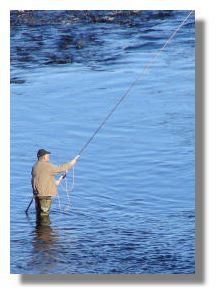 A conference of representatives from the tourist industry has been told that salmon fishing in Scotland could be expanded to create a £550 million boost to the Scottish economy. It is already a popular activity for many visitors to Scotland, but if more could be done to promote the attractions of Scotland's freshwater fishing, the numbers could be significantly expanded. It was argued that Scotland's world-class lochs and rivers should be promoted globally to entice even more tourists. Scotland can lay claim to being the historic home of salmon fishing but has to compete with global rivals.
A conference of representatives from the tourist industry has been told that salmon fishing in Scotland could be expanded to create a £550 million boost to the Scottish economy. It is already a popular activity for many visitors to Scotland, but if more could be done to promote the attractions of Scotland's freshwater fishing, the numbers could be significantly expanded. It was argued that Scotland's world-class lochs and rivers should be promoted globally to entice even more tourists. Scotland can lay claim to being the historic home of salmon fishing but has to compete with global rivals.
Stay of Execution for Sale of Sports Stadium
After months of campaigning by local residents against the demolition of Meadowbank sports stadium, Edinburgh City Council has agreed to "re-open and examine the principle of the sale". The plan had been to sell the site in the east of the city and build a new facility at Sighthill in the west, with a new, smaller venue at Meadowbank. Now the council will look again at all possible options over the future of Meadowbank. There is still a suspicion that the review could still recommend the original council plan, due to limitations on the amount of finance available, so the lobby groups will continue to press for a satisfactory outcome.
Kibble Palace Attracts More Visitors
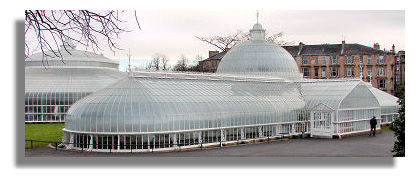
The glass covered conservatory in Glasgow's West End, known as the Kibble Palace, has attracted a massive135,000 visitors since it reopened five months ago, after a £7 million restoration. Its busiest weekend was last month, when it hosted an Orchid Fair and nearly 9,000 people visited the attraction over the two days. The iron and glass structure was gifted to the city by John Kibble in 1873. The Palace is now used for the cultivation of temperate plants, in particular, a collection of Australian tree ferns, some of which have lived there for 120 years.
Scotland the Wave
Before 180 of the world's top surfers arrived at Thurso beach in the north of Scotland for the second World Qualifying Series event, they had been competing in the warm sunshine at Copacabana Beach in Brazil. Even though they had to wear rubber wet suits, gloves and hoods for the cold conditions of the North Sea, the champion surfers said that the Thurso waves had been the best on the tour, allowing them to reach a high standard of performance. In some of the sessions, they experienced "stand-up barrels", meaning that they could stand upright as the wave barrels around them. They were reported to be back on the beach speechless - not because of the cold, but because they couldn't believe the quality of the waves. At the end of the O'Neill Highland Open, it was Australian Nathan Edge who won the final and the competition's prized trophy sword.
The Bottle Imp
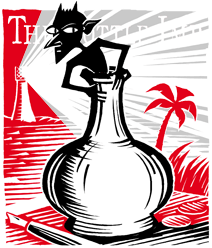 The Association for Scottish Literary Studies has launched a new ezine named "The Bottle Imp" - named after one of Robert Louis Stevenson's short stories. The ezine's first issue covers a lot of ground, including an article on the historical relationship between Scotland and America and the latest publications on Scottish literature and culture. Then there's an article entitled "Why Everybody Needs Smeddum" which gives a fresh insight into the language as well as the imagery of Lewis Grassic Gibbon's short story "Smeddum". The word itself means 'spirit', 'determination', 'true grit'. See The Bottle Imp.
The Association for Scottish Literary Studies has launched a new ezine named "The Bottle Imp" - named after one of Robert Louis Stevenson's short stories. The ezine's first issue covers a lot of ground, including an article on the historical relationship between Scotland and America and the latest publications on Scottish literature and culture. Then there's an article entitled "Why Everybody Needs Smeddum" which gives a fresh insight into the language as well as the imagery of Lewis Grassic Gibbon's short story "Smeddum". The word itself means 'spirit', 'determination', 'true grit'. See The Bottle Imp.
Scotland's Most Northerly Point Sold
Largely because of the eight-sided house built by a Dutchman, Jan de Groot, a ferryman in the reign of King James IV (1488 - 1513), John o' Groats is widely regarded as the most northerly place on the British mainland. In reality, the peninsula of Dunnet Head that should have that title. This week, Scottish Water sold a small plot of land there of just 250 square feet for £1,600. It has commanding views over the Pentland Firth to the Orkney Islands; Scottish Water say that you cannot go any further north in mainland Scotland "without getting your feet wet".
Over the Sea to Eilean a' Cheň
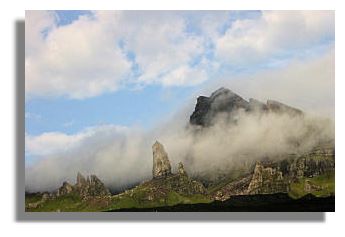 Initial reports on a decision by Highland Council to change the name of the Isle of Skye to a Gaelic name of Eilean a' Cheň, suggested that the iconic name was to disappear from the map. It was said that all council documents would use the name and officials responding to tourist enquiries were to use the new name. It was asserted that the change would abolish the anglicised "slave" name and was welcomed by the 40% of the residents who claim to speak Gaelic. However, there were howls of protest, not just from the 60% on the island who do not speak Gaelic and would have problems getting their tongues round Eilean a' Cheň - roughly pronounced "ellan-uh-ch-yaw" and meaning "Island of the Mists". Tourism business were outraged, arguing that it was throwing away the Skye marketing name that was known across the globe and would have a detrimental impact on the 250,000 tourists who come to the island each year. And anyway, Skye is from the Gaelic "Sgiathach" meaning "winged" - a reference to the shape of the island's peninsulas. It appeared also that the Highland Council had not consulted anyone about the change which came as a complete surprise. Faced with the protests, the local authority then said that the name really only applied to the ward in the council elections and that "Isle of Skye" would continue. So dog records will not have to be changed to Eilean a' Cheň terriers after all....
Initial reports on a decision by Highland Council to change the name of the Isle of Skye to a Gaelic name of Eilean a' Cheň, suggested that the iconic name was to disappear from the map. It was said that all council documents would use the name and officials responding to tourist enquiries were to use the new name. It was asserted that the change would abolish the anglicised "slave" name and was welcomed by the 40% of the residents who claim to speak Gaelic. However, there were howls of protest, not just from the 60% on the island who do not speak Gaelic and would have problems getting their tongues round Eilean a' Cheň - roughly pronounced "ellan-uh-ch-yaw" and meaning "Island of the Mists". Tourism business were outraged, arguing that it was throwing away the Skye marketing name that was known across the globe and would have a detrimental impact on the 250,000 tourists who come to the island each year. And anyway, Skye is from the Gaelic "Sgiathach" meaning "winged" - a reference to the shape of the island's peninsulas. It appeared also that the Highland Council had not consulted anyone about the change which came as a complete surprise. Faced with the protests, the local authority then said that the name really only applied to the ward in the council elections and that "Isle of Skye" would continue. So dog records will not have to be changed to Eilean a' Cheň terriers after all....
Picture of Old Man of Storr, Skye via Wikipedia.
Otter Numbers Increase
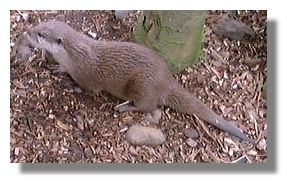 A survey, by Scottish Natural Heritage, has shown that otters are being found in parts of the country where they had vanished many years ago. The devastation of river fish stocks by chemicals and pollution in the 1960s and 1970s resulted in a dramatic fall in otter numbers. They had also been hunted for "sport" and because they were thought to kill game birds and reduce the catches of anglers. With a population of around 8,000 otters, Scotland is home to the majority of British otters and has one of the biggest populations of this attractive mammal in Europe. The recent increase in their numbers is seen as a positive indication of clean water and reduced persecution. It became illegal in 1981 to kill otters and they are also strictly protected by European law.
A survey, by Scottish Natural Heritage, has shown that otters are being found in parts of the country where they had vanished many years ago. The devastation of river fish stocks by chemicals and pollution in the 1960s and 1970s resulted in a dramatic fall in otter numbers. They had also been hunted for "sport" and because they were thought to kill game birds and reduce the catches of anglers. With a population of around 8,000 otters, Scotland is home to the majority of British otters and has one of the biggest populations of this attractive mammal in Europe. The recent increase in their numbers is seen as a positive indication of clean water and reduced persecution. It became illegal in 1981 to kill otters and they are also strictly protected by European law.
Return of the Heather Hopper
Following a pilot project last year, a bus service through some of the most spectacular scenery in the Cairngorms National Park is to operate again this summer. Starting on May 14, the "Heather Hopper" is the only cross-park bus link and operates twice a day, between Strathspey and Deeside. Although aimed at visitors to the park, it proved to be useful also to local residents along the way.
We've to Start Loving the Much-Maligned Moth
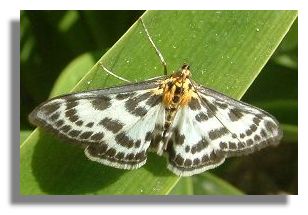 It is said that the public image of moths is that they are brown, boring, fly at night - and eat our clothes. But the Butterfly Conservation Society (which includes moths in its work) has just launched a campaign to persuade us that we should really love moths. They help to pollinate plants, provide food for garden birds and bats - and can be just as spectacularly coloured as their better loved cousins, the butterfly. The illustration here is of a Small Magpie Moth, showing that not all mothys are brown! And only about a half-dozen of Britain's 2,500 species of moths actually damage clothes. Many species of moth have been in decline since the late 1960s, some by well over 90%. Some rare UK species are just hanging on in Scotland. The charity has launched "Moths Count", which will recruit volunteers to carry out the largest-ever moth monitoring project. Whether the project will be successful in producing new enthusiasts - known as "moth-ers" - remains to be seen.
It is said that the public image of moths is that they are brown, boring, fly at night - and eat our clothes. But the Butterfly Conservation Society (which includes moths in its work) has just launched a campaign to persuade us that we should really love moths. They help to pollinate plants, provide food for garden birds and bats - and can be just as spectacularly coloured as their better loved cousins, the butterfly. The illustration here is of a Small Magpie Moth, showing that not all mothys are brown! And only about a half-dozen of Britain's 2,500 species of moths actually damage clothes. Many species of moth have been in decline since the late 1960s, some by well over 90%. Some rare UK species are just hanging on in Scotland. The charity has launched "Moths Count", which will recruit volunteers to carry out the largest-ever moth monitoring project. Whether the project will be successful in producing new enthusiasts - known as "moth-ers" - remains to be seen.
Overview of Last Month's Weather
The Meteorological Office has published the figures for April's weather and they confirm that it was an exceptionally warm month, compared to the long-term averages. All districts and regions set new maximum and average temperature records. Parts of eastern Scotland were over 5C above the 1961-1990 average. For Scotland as a whole, this April was 3.4C above the average. Rainfall was also well below normal, producing only 63% of the 1961-1990 average. It was also the sunniest April since 1974, with sunshine being recorded for 189 hours, which is 138% of the long-term average for the month.
Weather in Scotland This Week
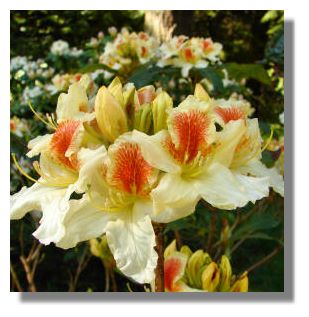 April's warm, dry and sunny weather continued into May. In the morning, it sometimes took a while for the thin cloud, which had been pushed in from the east coast, to roll back. And it was definitely the west that got the best of the clear blue skies and higher temperatures. On Wednesday, for example, although the sun eventually broke through in Aberdeen, the maximum temperature was only 11C (52F); in Glasgow and the west, the sun broke through by 10am and the thermometer reached 21C (70F). On a number of days, there was wall-to-wall sunshine for most of the day in the west, but east coast locations often had to wait till the afternoon before seeing the sun. Once again, there was no rain recorded anywhere in Scotland this week. The outlook, however, is for more cloud and some showers over the next few days - which will be welcomed by farmers and gardeners.
April's warm, dry and sunny weather continued into May. In the morning, it sometimes took a while for the thin cloud, which had been pushed in from the east coast, to roll back. And it was definitely the west that got the best of the clear blue skies and higher temperatures. On Wednesday, for example, although the sun eventually broke through in Aberdeen, the maximum temperature was only 11C (52F); in Glasgow and the west, the sun broke through by 10am and the thermometer reached 21C (70F). On a number of days, there was wall-to-wall sunshine for most of the day in the west, but east coast locations often had to wait till the afternoon before seeing the sun. Once again, there was no rain recorded anywhere in Scotland this week. The outlook, however, is for more cloud and some showers over the next few days - which will be welcomed by farmers and gardeners.
The illustration here shows an Azalea at Culzean Castle Country Park.
This Week's Colour Supplement
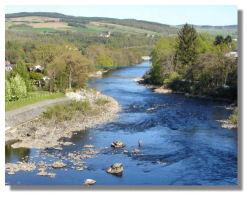 This week's large format photographs taken in Scotland to show the current season and its flora and fauna include Orange Tip butterflies; three-petalled Trillium in the woodlands of Cluny House in Perthshire; Atholl Palace Hotel, Pitlochry; "Sma' Glen" between Crieff and Aberfeldy; Doronicum in Culzean Castle Country Park; Wade's Bridge, Aberfeldy; salmon fisherman in the river Tummel at Pitlochry (see thumbnail here). See all the graphics in This Week's Colour Supplement.
This week's large format photographs taken in Scotland to show the current season and its flora and fauna include Orange Tip butterflies; three-petalled Trillium in the woodlands of Cluny House in Perthshire; Atholl Palace Hotel, Pitlochry; "Sma' Glen" between Crieff and Aberfeldy; Doronicum in Culzean Castle Country Park; Wade's Bridge, Aberfeldy; salmon fisherman in the river Tummel at Pitlochry (see thumbnail here). See all the graphics in This Week's Colour Supplement.
|
The Scottish Snippets Newsletter in its original format began in April 1997 and continued in an unbroken series for 591 issues. Although no longer produced in that format there is now a regular update on the new and updated pages on the Rampant Scotland site and also "Scottie's Diary" on an intermittent basis, To receive this, kust send an e-mail to Scottie with "Subscribe Newsletter" in the subject line.
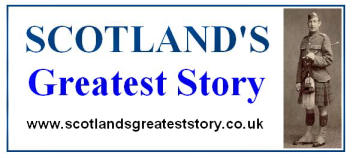

 When the voting system for the devolved Scottish Parliament was drawn up, it was essential to introduce an element of proportional representation. Otherwise, a "first past the post" system would have produced a perpetual Labour government. In the first two elections, the majority Labour party needed the support of the Liberal Democrats to create a coalition government. This week, the Scottish National Party (SNP) became the largest single party - but by the slenderest margin of one seat. Now, neither the SNP or Labour have enough seats to form a majority coalition with the Liberal Democrats - even if the LibDems wanted to join such an alliance. The full results of Thursday's election were:
When the voting system for the devolved Scottish Parliament was drawn up, it was essential to introduce an element of proportional representation. Otherwise, a "first past the post" system would have produced a perpetual Labour government. In the first two elections, the majority Labour party needed the support of the Liberal Democrats to create a coalition government. This week, the Scottish National Party (SNP) became the largest single party - but by the slenderest margin of one seat. Now, neither the SNP or Labour have enough seats to form a majority coalition with the Liberal Democrats - even if the LibDems wanted to join such an alliance. The full results of Thursday's election were: While the SNP made major gains, the Labour Party did not lose as many seats as had been predicted - it had been thought that, even though this was a Scottish election, many voters wanted to "give Tony Blair a kicking". It was the smaller parties - Green Party, Scottish Socialists and Independents who were squeezed out. Even the Conservatives and Liberal Democrats lost ground.
While the SNP made major gains, the Labour Party did not lose as many seats as had been predicted - it had been thought that, even though this was a Scottish election, many voters wanted to "give Tony Blair a kicking". It was the smaller parties - Green Party, Scottish Socialists and Independents who were squeezed out. Even the Conservatives and Liberal Democrats lost ground.
 No, the result was not a shambles. But due to a combination of factors, the election process itself became almost farcical, detracting attention from the results themselves. It meant that over 100,000 ballot papers were rejected due to being incorrectly completed - that's about 5% of all the votes and more than enough to have made a big difference in the outcome. First of all, a huge increase in the number of applications for a postal vote, resulted in many postal ballot papers not arriving before polling day. Then the ballot papers for the constituency vote and the regional list were combined onto one ballot paper. Confronted with a long list of candidates and a statement at the top that "You have two votes" induced some voters to put two crosses in one column, instead of one in each. Having "Alex Salmond for First Minister" at the top of the regional list also threw some people. It was a smart and legal move to head the alphabetical list, but he wasn't standing as a regional candidate in most regions. Then, to confuse us further, the election for local government candidates was held on the same day. Due to the "single transferable vote" system, voters here had to record their preferences in numerical order - 1,2,3 etc. After decades of putting a cross on the ballot paper, that proved confusing for some. Then the ballot papers had to be put in the boxes unfolded for the sake of the electronic readers. The electronic equipment reading all the ballot papers, faced with a large number of rejections, struggled to cope and delayed the production of the results. The Electoral Commission is to undertake a full enquiry into what went wrong and there are calls for a full, independent investigation.
No, the result was not a shambles. But due to a combination of factors, the election process itself became almost farcical, detracting attention from the results themselves. It meant that over 100,000 ballot papers were rejected due to being incorrectly completed - that's about 5% of all the votes and more than enough to have made a big difference in the outcome. First of all, a huge increase in the number of applications for a postal vote, resulted in many postal ballot papers not arriving before polling day. Then the ballot papers for the constituency vote and the regional list were combined onto one ballot paper. Confronted with a long list of candidates and a statement at the top that "You have two votes" induced some voters to put two crosses in one column, instead of one in each. Having "Alex Salmond for First Minister" at the top of the regional list also threw some people. It was a smart and legal move to head the alphabetical list, but he wasn't standing as a regional candidate in most regions. Then, to confuse us further, the election for local government candidates was held on the same day. Due to the "single transferable vote" system, voters here had to record their preferences in numerical order - 1,2,3 etc. After decades of putting a cross on the ballot paper, that proved confusing for some. Then the ballot papers had to be put in the boxes unfolded for the sake of the electronic readers. The electronic equipment reading all the ballot papers, faced with a large number of rejections, struggled to cope and delayed the production of the results. The Electoral Commission is to undertake a full enquiry into what went wrong and there are calls for a full, independent investigation.
 This week, the tourism agency VisitScotland published the figures on the number of visitors to Scotland's top tourist attractions last year. Nobody was surprised that the newly refurbished Kelvingrove Art Gallery and Museum (pictured here) had overtaken Edinburgh Castle for the top spot. Despite only being open for less than six months in 2006, Kelvingrove welcomed 1.9 visitors. Edinburgh Castle, with 1.2 million people through its gates, was the second busiest location - and the top location with an entrance fee. Edinburgh Zoo and Edinburgh Bus Tours followed the castle as Scotland's top paid-for attractions. Glasgow Science Centre and Blair Drummond Safari Park were 4th and 5th respectively. Of the free attractions, the National Gallery of Scotland and the National Museum of Scotland (both in Edinburgh) were high on the list, followed by the Old Blacksmith's Shop Centre in Gretna Green and Edinburgh's Royal Botanic Garden. Rosslyn Chapel in Midlothian, made famous by Dan Brown's best-selling novel, The Da Vinci code, saw numbers almost double between 2005 and 2006.
This week, the tourism agency VisitScotland published the figures on the number of visitors to Scotland's top tourist attractions last year. Nobody was surprised that the newly refurbished Kelvingrove Art Gallery and Museum (pictured here) had overtaken Edinburgh Castle for the top spot. Despite only being open for less than six months in 2006, Kelvingrove welcomed 1.9 visitors. Edinburgh Castle, with 1.2 million people through its gates, was the second busiest location - and the top location with an entrance fee. Edinburgh Zoo and Edinburgh Bus Tours followed the castle as Scotland's top paid-for attractions. Glasgow Science Centre and Blair Drummond Safari Park were 4th and 5th respectively. Of the free attractions, the National Gallery of Scotland and the National Museum of Scotland (both in Edinburgh) were high on the list, followed by the Old Blacksmith's Shop Centre in Gretna Green and Edinburgh's Royal Botanic Garden. Rosslyn Chapel in Midlothian, made famous by Dan Brown's best-selling novel, The Da Vinci code, saw numbers almost double between 2005 and 2006.
 A conference of representatives from the tourist industry has been told that salmon fishing in Scotland could be expanded to create a £550 million boost to the Scottish economy. It is already a popular activity for many visitors to Scotland, but if more could be done to promote the attractions of Scotland's freshwater fishing, the numbers could be significantly expanded. It was argued that Scotland's world-class lochs and rivers should be promoted globally to entice even more tourists. Scotland can lay claim to being the historic home of salmon fishing but has to compete with global rivals.
A conference of representatives from the tourist industry has been told that salmon fishing in Scotland could be expanded to create a £550 million boost to the Scottish economy. It is already a popular activity for many visitors to Scotland, but if more could be done to promote the attractions of Scotland's freshwater fishing, the numbers could be significantly expanded. It was argued that Scotland's world-class lochs and rivers should be promoted globally to entice even more tourists. Scotland can lay claim to being the historic home of salmon fishing but has to compete with global rivals. 
 The Association for Scottish Literary Studies has launched a new ezine named "The Bottle Imp" - named after one of Robert Louis Stevenson's short stories. The ezine's first issue covers a lot of ground, including an article on the historical relationship between Scotland and America and the latest publications on Scottish literature and culture. Then there's an article entitled "Why Everybody Needs Smeddum" which gives a fresh insight into the language as well as the imagery of Lewis Grassic Gibbon's short story "Smeddum". The word itself means 'spirit', 'determination', 'true grit'. See
The Association for Scottish Literary Studies has launched a new ezine named "The Bottle Imp" - named after one of Robert Louis Stevenson's short stories. The ezine's first issue covers a lot of ground, including an article on the historical relationship between Scotland and America and the latest publications on Scottish literature and culture. Then there's an article entitled "Why Everybody Needs Smeddum" which gives a fresh insight into the language as well as the imagery of Lewis Grassic Gibbon's short story "Smeddum". The word itself means 'spirit', 'determination', 'true grit'. See  Initial reports on a decision by Highland Council to change the name of the Isle of Skye to a Gaelic name of Eilean a' Cheň, suggested that the iconic name was to disappear from the map. It was said that all council documents would use the name and officials responding to tourist enquiries were to use the new name. It was asserted that the change would abolish the anglicised "slave" name and was welcomed by the 40% of the residents who claim to speak Gaelic. However, there were howls of protest, not just from the 60% on the island who do not speak Gaelic and would have problems getting their tongues round Eilean a' Cheň - roughly pronounced "ellan-uh-ch-yaw" and meaning "Island of the Mists". Tourism business were outraged, arguing that it was throwing away the Skye marketing name that was known across the globe and would have a detrimental impact on the 250,000 tourists who come to the island each year. And anyway, Skye is from the Gaelic "Sgiathach" meaning "winged" - a reference to the shape of the island's peninsulas. It appeared also that the Highland Council had not consulted anyone about the change which came as a complete surprise. Faced with the protests, the local authority then said that the name really only applied to the ward in the council elections and that "Isle of Skye" would continue. So dog records will not have to be changed to Eilean a' Cheň terriers after all....
Initial reports on a decision by Highland Council to change the name of the Isle of Skye to a Gaelic name of Eilean a' Cheň, suggested that the iconic name was to disappear from the map. It was said that all council documents would use the name and officials responding to tourist enquiries were to use the new name. It was asserted that the change would abolish the anglicised "slave" name and was welcomed by the 40% of the residents who claim to speak Gaelic. However, there were howls of protest, not just from the 60% on the island who do not speak Gaelic and would have problems getting their tongues round Eilean a' Cheň - roughly pronounced "ellan-uh-ch-yaw" and meaning "Island of the Mists". Tourism business were outraged, arguing that it was throwing away the Skye marketing name that was known across the globe and would have a detrimental impact on the 250,000 tourists who come to the island each year. And anyway, Skye is from the Gaelic "Sgiathach" meaning "winged" - a reference to the shape of the island's peninsulas. It appeared also that the Highland Council had not consulted anyone about the change which came as a complete surprise. Faced with the protests, the local authority then said that the name really only applied to the ward in the council elections and that "Isle of Skye" would continue. So dog records will not have to be changed to Eilean a' Cheň terriers after all....
 A survey, by Scottish Natural Heritage, has shown that otters are being found in parts of the country where they had vanished many years ago. The devastation of river fish stocks by chemicals and pollution in the 1960s and 1970s resulted in a dramatic fall in otter numbers. They had also been hunted for "sport" and because they were thought to kill game birds and reduce the catches of anglers. With a population of around 8,000 otters, Scotland is home to the majority of British otters and has one of the biggest populations of this attractive mammal in Europe. The recent increase in their numbers is seen as a positive indication of clean water and reduced persecution. It became illegal in 1981 to kill otters and they are also strictly protected by European law.
A survey, by Scottish Natural Heritage, has shown that otters are being found in parts of the country where they had vanished many years ago. The devastation of river fish stocks by chemicals and pollution in the 1960s and 1970s resulted in a dramatic fall in otter numbers. They had also been hunted for "sport" and because they were thought to kill game birds and reduce the catches of anglers. With a population of around 8,000 otters, Scotland is home to the majority of British otters and has one of the biggest populations of this attractive mammal in Europe. The recent increase in their numbers is seen as a positive indication of clean water and reduced persecution. It became illegal in 1981 to kill otters and they are also strictly protected by European law.
 It is said that the public image of moths is that they are brown, boring, fly at night - and eat our clothes. But the Butterfly Conservation Society (which includes moths in its work) has just launched a campaign to persuade us that we should really love moths. They help to pollinate plants, provide food for garden birds and bats - and can be just as spectacularly coloured as their better loved cousins, the butterfly. The illustration here is of a Small Magpie Moth, showing that not all mothys are brown! And only about a half-dozen of Britain's 2,500 species of moths actually damage clothes. Many species of moth have been in decline since the late 1960s, some by well over 90%. Some rare UK species are just hanging on in Scotland. The charity has launched "Moths Count", which will recruit volunteers to carry out the largest-ever moth monitoring project. Whether the project will be successful in producing new enthusiasts - known as "moth-ers" - remains to be seen.
It is said that the public image of moths is that they are brown, boring, fly at night - and eat our clothes. But the Butterfly Conservation Society (which includes moths in its work) has just launched a campaign to persuade us that we should really love moths. They help to pollinate plants, provide food for garden birds and bats - and can be just as spectacularly coloured as their better loved cousins, the butterfly. The illustration here is of a Small Magpie Moth, showing that not all mothys are brown! And only about a half-dozen of Britain's 2,500 species of moths actually damage clothes. Many species of moth have been in decline since the late 1960s, some by well over 90%. Some rare UK species are just hanging on in Scotland. The charity has launched "Moths Count", which will recruit volunteers to carry out the largest-ever moth monitoring project. Whether the project will be successful in producing new enthusiasts - known as "moth-ers" - remains to be seen. April's warm, dry and sunny weather continued into May. In the morning, it sometimes took a while for the thin cloud, which had been pushed in from the east coast, to roll back. And it was definitely the west that got the best of the clear blue skies and higher temperatures. On Wednesday, for example, although the sun eventually broke through in Aberdeen, the maximum temperature was only 11C (52F); in Glasgow and the west, the sun broke through by 10am and the thermometer reached 21C (70F). On a number of days, there was wall-to-wall sunshine for most of the day in the west, but east coast locations often had to wait till the afternoon before seeing the sun. Once again, there was no rain recorded anywhere in Scotland this week. The outlook, however, is for more cloud and some showers over the next few days - which will be welcomed by farmers and gardeners.
April's warm, dry and sunny weather continued into May. In the morning, it sometimes took a while for the thin cloud, which had been pushed in from the east coast, to roll back. And it was definitely the west that got the best of the clear blue skies and higher temperatures. On Wednesday, for example, although the sun eventually broke through in Aberdeen, the maximum temperature was only 11C (52F); in Glasgow and the west, the sun broke through by 10am and the thermometer reached 21C (70F). On a number of days, there was wall-to-wall sunshine for most of the day in the west, but east coast locations often had to wait till the afternoon before seeing the sun. Once again, there was no rain recorded anywhere in Scotland this week. The outlook, however, is for more cloud and some showers over the next few days - which will be welcomed by farmers and gardeners.
 This week's large format photographs taken in Scotland to show the current season and its flora and fauna include Orange Tip butterflies; three-petalled Trillium in the woodlands of Cluny House in Perthshire; Atholl Palace Hotel, Pitlochry; "Sma' Glen" between Crieff and Aberfeldy; Doronicum in Culzean Castle Country Park; Wade's Bridge, Aberfeldy; salmon fisherman in the river Tummel at Pitlochry (see thumbnail here). See all the graphics in
This week's large format photographs taken in Scotland to show the current season and its flora and fauna include Orange Tip butterflies; three-petalled Trillium in the woodlands of Cluny House in Perthshire; Atholl Palace Hotel, Pitlochry; "Sma' Glen" between Crieff and Aberfeldy; Doronicum in Culzean Castle Country Park; Wade's Bridge, Aberfeldy; salmon fisherman in the river Tummel at Pitlochry (see thumbnail here). See all the graphics in 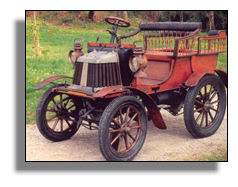 A 107-year-old car, built in Glasgow by the Argyll Motor Company, was sold at auction this week for £113,700. The first owner paid £258 for the car when it was new. The Argyll 5hp spindle rear entrance Tonneau has not been driven for the last 68 years. Indeed, it has spent the last 45 years in the living room of an eccentric artist from Dublin.
A 107-year-old car, built in Glasgow by the Argyll Motor Company, was sold at auction this week for £113,700. The first owner paid £258 for the car when it was new. The Argyll 5hp spindle rear entrance Tonneau has not been driven for the last 68 years. Indeed, it has spent the last 45 years in the living room of an eccentric artist from Dublin.
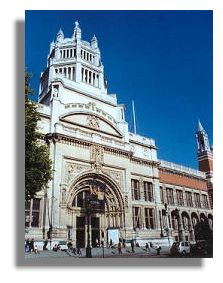 The Victoria and Albert Museum (known also as the "V&A") is one of the top tourist attractions in London, attracting 2.5 million visitors each year. The museum has begun a study to see if Dundee would be a suitable location for an off-shoot for some of its collection. Its art and design exhibits are a major attractions and Dundee University's Duncan of Jordanstone College of Art and Design would be used to help establish the V &A offshoot in the city. Such a development would reinforce the city's credentials as a cultural centre, as well as providing a boost to the visitor attractions in the City of Discovery.
The Victoria and Albert Museum (known also as the "V&A") is one of the top tourist attractions in London, attracting 2.5 million visitors each year. The museum has begun a study to see if Dundee would be a suitable location for an off-shoot for some of its collection. Its art and design exhibits are a major attractions and Dundee University's Duncan of Jordanstone College of Art and Design would be used to help establish the V &A offshoot in the city. Such a development would reinforce the city's credentials as a cultural centre, as well as providing a boost to the visitor attractions in the City of Discovery.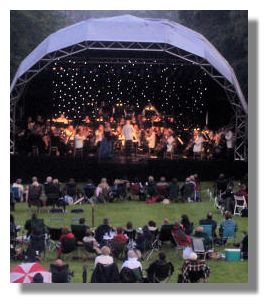 Raemoir House Hotel is close to Aberdeen, but in the glorious landscape of Royal Deeside. Once again it is hosting a Grand Summer Prom, featuring the Scottish Festival Orchestra and classical singer Nicky Spence. The spectacular programme includes grand orchestral works by Bizet, Grieg and Strauss along with the hauntingly beautiful Fingal's Cave overture by Mendelsshon. Set in the gardens of Raemoir House Hotel, the audience is being encouraged to bring along a low backed chair or a rug, have a picnic and enjoy all their favourite prom classics on a relaxing summer's evening. For more details, see
Raemoir House Hotel is close to Aberdeen, but in the glorious landscape of Royal Deeside. Once again it is hosting a Grand Summer Prom, featuring the Scottish Festival Orchestra and classical singer Nicky Spence. The spectacular programme includes grand orchestral works by Bizet, Grieg and Strauss along with the hauntingly beautiful Fingal's Cave overture by Mendelsshon. Set in the gardens of Raemoir House Hotel, the audience is being encouraged to bring along a low backed chair or a rug, have a picnic and enjoy all their favourite prom classics on a relaxing summer's evening. For more details, see 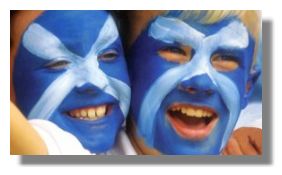 The main focus of the Scottish Snippets is news items, usually about Scotland but occasionally items from overseas are covered. The new "Scots Abroad" section, invites folk to write in about Scottish-related events in their part of the world. It allows publicity for them and an appreciation by others of just how much Scottish culture is perpetuated in every corner of the globe.
The main focus of the Scottish Snippets is news items, usually about Scotland but occasionally items from overseas are covered. The new "Scots Abroad" section, invites folk to write in about Scottish-related events in their part of the world. It allows publicity for them and an appreciation by others of just how much Scottish culture is perpetuated in every corner of the globe.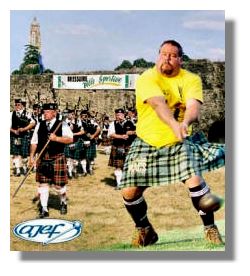 Bressuire, in western France, was twinned with Fraserburgh over fifteen years ago. They take the link seriously and have been staging a Highland Games in the French town every summer for many years. This year, this unique event is being held on 9/10 June in the local castle grounds. All the usual heavy events associated with traditional Highland games will be staged, including the shot putt, throwing the hammer and even tossing the caber. The Grampian Police Pipe Band will be performing for the French audience (peppered with a few visiting Scots) and the Clan Fraser Society in the UK will be represented there too.
Bressuire, in western France, was twinned with Fraserburgh over fifteen years ago. They take the link seriously and have been staging a Highland Games in the French town every summer for many years. This year, this unique event is being held on 9/10 June in the local castle grounds. All the usual heavy events associated with traditional Highland games will be staged, including the shot putt, throwing the hammer and even tossing the caber. The Grampian Police Pipe Band will be performing for the French audience (peppered with a few visiting Scots) and the Clan Fraser Society in the UK will be represented there too.
 Rangers defeat of Celtic on Saturday doesn't change the SPL title going to Celtic, of course, but it does mean that Aberdeen no longer have the possibility of overtaking the Ibrox side. So Rangers will be in the European Champions League next season. Aberdeen can still be overtaken by Hearts for the Uefa Cup place, as they are only 4 points ahead. The two teams play each other on Sunday - a win by Aberdeen, would make that European slot safe. St Mirren lost to relegation rivals Dunfermline earlier this week, but earned three valuable points on Saturday, giving them a 3 point cushion. Dunfermline do not play their match (against Motherwell) until Monday. There is then another head-to-head between the two bottom clubs next Saturday, which could resolve the issue.
Rangers defeat of Celtic on Saturday doesn't change the SPL title going to Celtic, of course, but it does mean that Aberdeen no longer have the possibility of overtaking the Ibrox side. So Rangers will be in the European Champions League next season. Aberdeen can still be overtaken by Hearts for the Uefa Cup place, as they are only 4 points ahead. The two teams play each other on Sunday - a win by Aberdeen, would make that European slot safe. St Mirren lost to relegation rivals Dunfermline earlier this week, but earned three valuable points on Saturday, giving them a 3 point cushion. Dunfermline do not play their match (against Motherwell) until Monday. There is then another head-to-head between the two bottom clubs next Saturday, which could resolve the issue.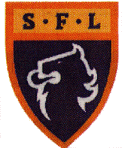 The play-offs between the second bottom club and the second to fourth club in the division below in the Scottish Football League are continuing.
The play-offs between the second bottom club and the second to fourth club in the division below in the Scottish Football League are continuing.
 The whisky brand Famous Grouse has been the shirt sponsor for the Scottish national rugby team for the last 16 years, in a deal which is thought to be worth around a million pounds to the sport. But the Eddrington Group, owner of the brand since 1999, announced this week that they will be withdrawing after this year's World Cup. The Scottish rugby squad won the Grand Slam in 1990, near the start of the whisky company's sponsorship, but in recent years the team has not performed well. In this season's 6 Nations Rugby tournament, the Scotland won the "wooden spoon", winning just one match in five - and managing to lose (again) to Italy. The Scottish Rugby Union will find it hard to find another high-level, loyal sponsor.
The whisky brand Famous Grouse has been the shirt sponsor for the Scottish national rugby team for the last 16 years, in a deal which is thought to be worth around a million pounds to the sport. But the Eddrington Group, owner of the brand since 1999, announced this week that they will be withdrawing after this year's World Cup. The Scottish rugby squad won the Grand Slam in 1990, near the start of the whisky company's sponsorship, but in recent years the team has not performed well. In this season's 6 Nations Rugby tournament, the Scotland won the "wooden spoon", winning just one match in five - and managing to lose (again) to Italy. The Scottish Rugby Union will find it hard to find another high-level, loyal sponsor.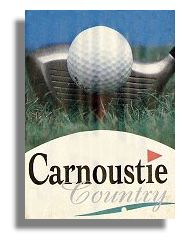 When this year's Open Golf Championship begins at Carnoustie on 19 July, it will be played on the longest course in the event's history. At 7,421 yards, it will be 60 yards longer than in 1999, when a combination of the long course, long rough and blustery weather, led to it being nicknamed by some of the players "Car-Nasty". The 1999 Open at Carnoustie was the highest scoring tournament since 1947 and the highest in any major golf championship since 1963. Scotland's Paul Lawrie won the claret jug that year in a three-way play-off when they finished six over par. While Carnoustie is breaking records for The Open, the course will actually be 24 yard shorter than Augusta, where the Masters was staged last month.
When this year's Open Golf Championship begins at Carnoustie on 19 July, it will be played on the longest course in the event's history. At 7,421 yards, it will be 60 yards longer than in 1999, when a combination of the long course, long rough and blustery weather, led to it being nicknamed by some of the players "Car-Nasty". The 1999 Open at Carnoustie was the highest scoring tournament since 1947 and the highest in any major golf championship since 1963. Scotland's Paul Lawrie won the claret jug that year in a three-way play-off when they finished six over par. While Carnoustie is breaking records for The Open, the course will actually be 24 yard shorter than Augusta, where the Masters was staged last month.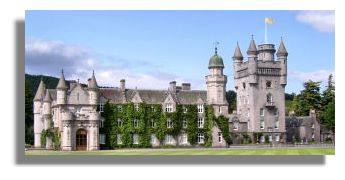 The athletics meeting, held each year in the Queen's estate at Balmoral, attracted a crowd of 7,000 last weekend. They sweltered in the sun as 3,000 athletes competed in a number of races. Organisers said that it was the most successful Balmoral event they had ever organised. Robert Russell from Dunblane triumphed in the Stena Drilling Tartan 10 kilometre race and also set a new course record for that distance of 31 minutes and 20 seconds. There were a large number of sideshows to make it a family day out and it is estimated that the local economy benefitted to the tune of £130,000.
The athletics meeting, held each year in the Queen's estate at Balmoral, attracted a crowd of 7,000 last weekend. They sweltered in the sun as 3,000 athletes competed in a number of races. Organisers said that it was the most successful Balmoral event they had ever organised. Robert Russell from Dunblane triumphed in the Stena Drilling Tartan 10 kilometre race and also set a new course record for that distance of 31 minutes and 20 seconds. There were a large number of sideshows to make it a family day out and it is estimated that the local economy benefitted to the tune of £130,000.



